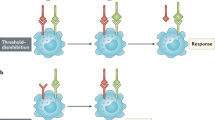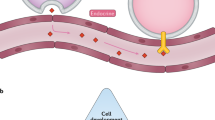Abstract
The analysis of lymphocyte signaling was greatly enhanced by the advent of gene targeting, which allows the selective inactivation of a single gene. Although this gene 'knockout' approach is often informative, in many cases, the phenotype resulting from gene ablation might not provide a complete picture of the function of the corresponding protein. If a protein has multiple functions within a single or several signaling pathways, or stabilizes other proteins in a complex, the phenotypic consequences of a gene knockout may manifest as a combination of several different perturbations. In these cases, gene targeting to 'knock in' subtle point mutations might provide more accurate insight into protein function. However, to be informative, such mutations must be carefully based on structural and biophysical data.
This is a preview of subscription content, access via your institution
Access options
Subscribe to this journal
Receive 12 print issues and online access
$209.00 per year
only $17.42 per issue
Buy this article
- Purchase on Springer Link
- Instant access to full article PDF
Prices may be subject to local taxes which are calculated during checkout

Similar content being viewed by others
References
Kadlecek, T.A. et al. Differential requirements for ZAP-70 in TCR signaling and T cell development. J. Immunol. 161, 4688–4694 (1998).
Negishi, I. et al. Essential role for ZAP-70 in both positive and negative selection of thymocytes. Nature 376, 435–438 (1995).
Clements, J.L. et al. Requirement for the leukocyte-specific adapter protein SLP-76 for normal T cell development. Science 281, 416–419 (1998).
Pivniouk, V. et al. Impaired viability and profound block in thymocyte development in mice lacking the adaptor protein SLP-76. Cell 94, 229–238 (1998).
Zhang, W. et al. Essential role of LAT in T cell development. Immunity 10, 323–332 (1999).
Kuhn, R. & Torres, R.M. Cre/loxP recombination system and gene targeting. Methods Mol. Biol. 180, 175–204 (2002).
Sugihara, K. et al. Rac1 is required for the formation of three germ layers during gastrulation. Oncogene 17, 3427–3433 (1998).
Walmsley, M.J. et al. Critical roles for Rac1 and Rac2 GTPases in B cell development and signaling. Science 302, 459–462 (2003).
Dumont, C. et al. Rac GTPases play critical roles in early T cell development. Blood published online, doi:10.1182/blood-2008-09-181180 (16 December 2008).
Jo, D. et al. Epigenetic regulation of gene structure and function with a cell-permeable Cre recombinase. Nat. Biotechnol. 19, 929–933 (2001).
Peitz, M., Pfannkuche, K., Rajewsky, K. & Edenhofer, F. Ability of the hydrophobic FGF and basic TAT peptides to promote cellular uptake of recombinant Cre recombinase: a tool for efficient genetic engineering of mammalian genomes. Proc. Natl. Acad. Sci. USA 99, 4489–4494 (2002).
Zha, Y., Shah, R., Locke, F., Wong, A. & Gajewski, T.F. Use of Cre-adenovirus and CAR transgenic mice for efficient deletion of genes in post-thymic T cells. J. Immunol. Methods 331, 94–102 (2008).
Tybulewicz, V.L.J. Vav-family proteins in T-cell signalling. Curr. Opin. Immunol. 17, 267–274 (2005).
Tybulewicz, V.L.J., Ardouin, L., Prisco, A. & Reynolds, L.F. Vav1: a key signal transducer downstream of the TCR. Immunol. Rev. 192, 42–52 (2003).
Zhang, W. et al. Association of Grb2, Gads, and phospholipase C-γ1 with phosphorylated LAT tyrosine residues. J. Biol. Chem. 275, 23355–23361 (2000).
Nunez-Cruz, S. et al. LAT regulates γδ T cell homeostasis and differentiation. Nat. Immunol. 4, 999–1008 (2003).
Sommers, C.L. et al. Knock-in mutation of the distal four tyrosines of linker for activation of T cells blocks murine T cell development. J. Exp. Med. 194, 135–142 (2001).
Aguado, E. et al. Induction of T helper type 2 immunity by a point mutation in the LAT adaptor. Science 296, 2036–2040 (2002).
Sommers, C.L. et al. A LAT mutation that inhibits T cell development yet induces lymphoproliferation. Science 296, 2040–2043 (2002).
Sommers, C.L. et al. Mutation of the phospholipase C-γ1-binding site of LAT affects both positive and negative thymocyte selection. J. Exp. Med. 201, 1125–1134 (2005).
Jordan, M.S. et al. Complementation in trans of altered thymocyte development in mice expressing mutant forms of the adaptor molecule SLP76. Immunity 28, 359–369 (2008).
Myung, P.S. et al. Differential requirement for SLP-76 domains in T cell development and function. Immunity 15, 1011–1026 (2001).
Wiest, D.L. et al. A spontaneously arising mutation in the DLAARN motif of murine ZAP-70 abrogates kinase activity and arrests thymocyte development. Immunity 6, 663–671 (1997).
Siggs, O.M. et al. Opposing functions of the T cell receptor kinase ZAP-70 in immunity and tolerance differentially titrate in response to nucleotide substitutions. Immunity 27, 912–926 (2007).
Sakaguchi, N. et al. Altered thymic T-cell selection due to a mutation of the ZAP-70 gene causes autoimmune arthritis in mice. Nature 426, 454–460 (2003).
Ananieva, O. et al. The kinases MSK1 and MSK2 act as negative regulators of Toll-like receptor signaling. Nat. Immunol. 9, 1028–1036 (2008).
Vanhaesebroeck, B., Ali, K., Bilancio, A., Geering, B. & Foukas, L.C. Signalling by PI3K isoforms: insights from gene-targeted mice. Trends Biochem. Sci. 30, 194–204 (2005).
Fruman, D.A. et al. Impaired B cell development and proliferation in absence of phosphoinositide 3-kinase p85α. Science 283, 393–397 (1999).
Lu-Kuo, J.M., Fruman, D.A., Joyal, D.M., Cantley, L.C. & Katz, H.R. Impaired kit- but not FcɛRI-initiated mast cell activation in the absence of phosphoinositide 3-kinase p85alpha gene products. J. Biol. Chem. 275, 6022–6029 (2000).
Clayton, E. et al. A crucial role for the p110δ subunit of phosphatidylinositol 3-kinase in B cell development and activation. J. Exp. Med. 196, 753–763 (2002).
Okkenhaug, K. et al. Impaired B and T cell antigen receptor signaling in p110δ PI 3-kinase mutant mice. Science 297, 1031–1034 (2002).
Li, Z. et al. Roles of PLC-β2 and -β3 and PI3Kγ in chemoattractant-mediated signal transduction. Science 287, 1046–1049 (2000).
Patrucco, E. et al. PI3Kγ modulates the cardiac response to chronic pressure overload by distinct kinase-dependent and -independent effects. Cell 118, 375–387 (2004).
Sasaki, T. et al. Function of PI3Kγ in thymocyte development, T cell activation, and neutrophil migration. Science 287, 1040–1046 (2000).
Thien, C.B. & Langdon, W.Y. Cbl: many adaptations to regulate protein tyrosine kinases. Nat. Rev. Mol. Cell Biol. 2, 294–307 (2001).
Thien, C.B. et al. Loss of c-Cbl RING finger function results in high-intensity TCR signaling and thymic deletion. EMBO J. 24, 3807–3819 (2005).
Thien, C.B. et al. A mouse with a loss-of-function mutation in the c-Cbl TKB domain shows perturbed thymocyte signaling without enhancing the activity of the ZAP-70 tyrosine kinase. J. Exp. Med. 197, 503–513 (2003).
Acknowledgements
We thank S. Ley and E. Schweighoffer for critical reading of the manuscript.
Author information
Authors and Affiliations
Corresponding author
Rights and permissions
About this article
Cite this article
Saveliev, A., Tybulewicz, V. Lymphocyte signaling: beyond knockouts. Nat Immunol 10, 361–364 (2009). https://doi.org/10.1038/ni.1709
Published:
Issue Date:
DOI: https://doi.org/10.1038/ni.1709
This article is cited by
-
Rho family GTPases and their regulators in lymphocytes
Nature Reviews Immunology (2009)



